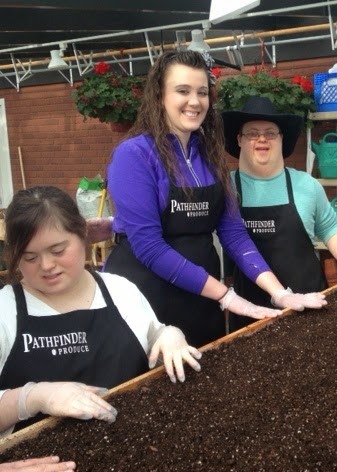 We hope everyone will join us this Thursday, March 26, for
another tasteful Pathfinder Produce fresh fruit and vegetable market, held at
the Village Commons from 2 to 5 p.m. We wish to thank all our patrons
who made last week’s second anniversary celebration a great success. We hope everyone will join us this Thursday, March 26, for
another tasteful Pathfinder Produce fresh fruit and vegetable market, held at
the Village Commons from 2 to 5 p.m. We wish to thank all our patrons
who made last week’s second anniversary celebration a great success.
****
 A few weeks ago, our
Vocational Program participants and Otsego Academy students worked with Brian
Belknap, our garden consultant, on planting the beds at the Button Greenhouse
with seeds for spinach, lettuce, and other greens. Mr. Belknap, the
Food Service Director at Edmeston Central School, is a great believer in
adding greens to nearly every meal, whether they’re fresh, steamed, sautéed,
or added to tasty smoothies for an added nutritional boost. A few weeks ago, our
Vocational Program participants and Otsego Academy students worked with Brian
Belknap, our garden consultant, on planting the beds at the Button Greenhouse
with seeds for spinach, lettuce, and other greens. Mr. Belknap, the
Food Service Director at Edmeston Central School, is a great believer in
adding greens to nearly every meal, whether they’re fresh, steamed, sautéed,
or added to tasty smoothies for an added nutritional boost.
Walking
through the greenhouse recently, I noticed the little plants have really
taken off and I’m looking forward to purchasing some greens once the staff
and students start harvesting them. I’m sure everyone is getting ready
to plant the larger beds in the 5210 Hoop House too; it looks like the
structure made it through the tough winter just fine, and it shouldn’t take
too much work to get the beds back into prime condition.
 On
the other hand, my own garden is a different and sad story. The three
four-by-eight raised beds remain under a covering of snow, and last year’s
sunflower stalks remind me of the work that needs to be done. I know
it’s time to replace the untreated wooden plank frames (they refuse to hold
together and some of the wood is well-rotted), rejuvenate the soil mix, and
maybe develop a hoop house of my own to control the weeds that are my annual
nemesis. On
the other hand, my own garden is a different and sad story. The three
four-by-eight raised beds remain under a covering of snow, and last year’s
sunflower stalks remind me of the work that needs to be done. I know
it’s time to replace the untreated wooden plank frames (they refuse to hold
together and some of the wood is well-rotted), rejuvenate the soil mix, and
maybe develop a hoop house of my own to control the weeds that are my annual
nemesis.
Of
course, I could also take a new direction and try something I saw in an old Mother
Earth News publication I saved. The article is called “How to Make
Instant No-dig Garden Beds” and offers several methods: The first is to
simply open small planting holes in the lawn sod and insert starter plants
(EASY); another method is to buy 40 lb. bags of soil, strategically place them
in the garden, and add drainage slits around the perimeter of each bag.
The author, Barbara Pleasant, suggests cutting off the tops of the bags and
putting in your starter plants, and then mulching around the young
seedlings. Tomato plants require one bag each, according to the
article.
Yet
another option is to use old hay or straw bales for planting. My dad
has done this a few times with potatoes, and had some nice results especially
as the spuds come out absolutely clean. Author Pleasant says these bale
gardens require a lot of water, and may need some liquid fertilizer, but that
they also attract earthworms, which are highly beneficial. More details
on this method are at www.no-dig-vegetablegarden.com/straw-bale-gardening.html.
(Straw bales are preferred over hay bales, as they tend to not have as many
weed seeds).
Bales
can also be used to outline a traditional bed filled with soil, especially if
you want a larger growing area. Or, if you’re creating a permanent bed,
you can outline your garden beds with non-rotting plastic planks, untreated
landscaping ties, or even decorative masonry blocks. (Be prepared for
some sticker shock with the plastic or masonry options).
Until
next time, be well, and we hope to see you at Pathfinder Produce!
Lori
|
Pathfinder Village's weekly produce market price list and "foodie facts" to encourage families to eat more healthful diets. Visit us each Thursday afternoon in Edmeston, NY for our Pathfinder Produce market.